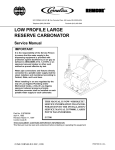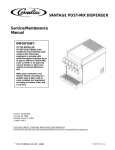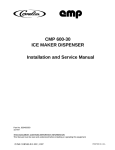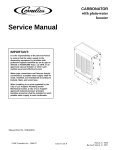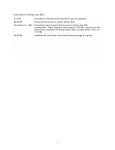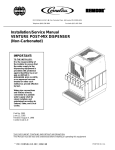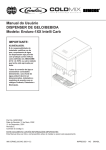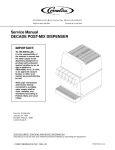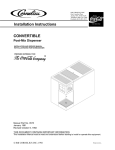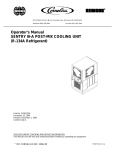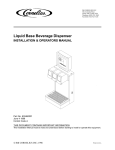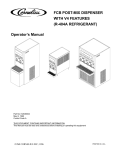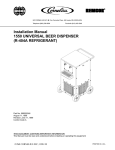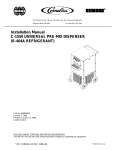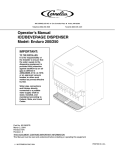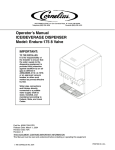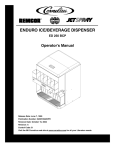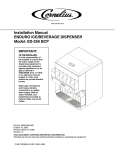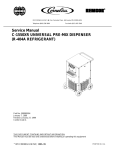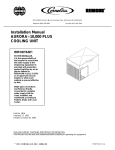Download Cornelius VANTAGE POST-MIX DISPENSER User's Manual
Transcript
VANTAGE POST-MIX DISPENSER Service/Maintenance Manual IMPORTANT: TO THE INSTALLER. It is the responsibility of the Installer to ensure that the water supply to the dispensing equipment is provided with protection against backflow by an air gap as defined in ANSI/ASME A112. 1.2-1979; or an approved vacuum breaker or other such method as proved effective by test. Water pipe connections and fixtures directly connected to a potable water supply shall be sized, installed, and maintained according to Federal, State, and Local laws. Part No. 312031004 January 26, 1996 Revised: March 3, 1998 Control Code C THIS DOCUMENT CONTAINS IMPORTANT INFORMATION This Manual must Ó IMI CORNELIUS INC; 1998 PRINTED IN U.S.A TABLE OF CONTENTS Page SAFETY INFORMATION . . . . . . . . . . . . . . . . . . . . . . . . . . . . . . . . . . . . . . . . . . . . . . . . . . . . 1 RECOGNIZE SAFETY INFORMATION . . . . . . . . . . . . . . . . . . . . . . . . . . . . . . . UNDERSTAND SIGNAL WORDS . . . . . . . . . . . . . . . . . . . . . . . . . . . . . . . . . . . . 1 1 FOLLOW SAFETY INSTRUCTIONS . . . . . . . . . . . . . . . . . . . . . . . . . . . . . . . . . CO2 (CARBON DIOXIDE) WARNING . . . . . . . . . . . . . . . . . . . . . . . . . . . . . . . . SHIPPING, STORING, OR RELOCATING UNIT . . . . . . . . . . . . . . . . . . . . . . . GENERAL INFORMATION . . . . . . . . . . . . . . . . . . . . . . . . . . . . . . . . . . . . . . . . . . . . . . . . . . 1 1 1 3 TO THE USER OF THIS MANUAL . . . . . . . . . . . . . . . . . . . . . . . . . . . . . . . . . . . . . . . CLAIMS INSTRUCTIONS . . . . . . . . . . . . . . . . . . . . . . . . . . . . . . . . . . . . . . . . . . . . . . WARRANTY REFERENCE INFORMATION . . . . . . . . . . . . . . . . . . . . . . . . . . . . . . . 3 3 3 DESIGN DATA . . . . . . . . . . . . . . . . . . . . . . . . . . . . . . . . . . . . . . . . . . . . . . . . . . . . . . . . THEORY OF OPERATION . . . . . . . . . . . . . . . . . . . . . . . . . . . . . . . . . . . . . . . . . . . . . . UNIT WITH INTEGRAL (BUILT-IN) COLD CARBONATOR . . . . . . . . . . . . . . UNIT REQUIRING REMOTE CARBONATOR . . . . . . . . . . . . . . . . . . . . . . . . . SERVICE AND MAINTENANCE . . . . . . . . . . . . . . . . . . . . . . . . . . . . . . . . . . . . . . . . . . . . . 3 4 4 4 7 PREPARING UNIT FOR SHIPPING OR RELOCATING . . . . . . . . . . . . . . . . . . . . . HOOD AND FRONT ACCESS PANEL REMOVAL . . . . . . . . . . . . . . . . . . . . . . . . . . 7 7 HOOD REMOVAL . . . . . . . . . . . . . . . . . . . . . . . . . . . . . . . . . . . . . . . . . . . . . . . . . FRONT ACCESS PANEL REMOVAL . . . . . . . . . . . . . . . . . . . . . . . . . . . . . . . . . PERIODIC INSPECTION . . . . . . . . . . . . . . . . . . . . . . . . . . . . . . . . . . . . . . . . . . . . . . . ADJUSTMENTS . . . . . . . . . . . . . . . . . . . . . . . . . . . . . . . . . . . . . . . . . . . . . . . . . . . . . . . CO2 REGULATORS ADJUSTMENTS . . . . . . . . . . . . . . . . . . . . . . . . . . . . . . . . ADJUSTING DISPENSING VALVES WATER FLOW RATE . . . . . . . . . . . . . 7 7 7 10 10 10 ADJUSTING WATER-TO-SYRUP “RATIO”(BRIX) OF DISPENSED PRODUCT . . . . . . . . . . . . . . . . . . . . . . . . . . . . . . . . . . . . . . . . . . . . . . . . . . . . . . . . CLEANING AND SANITIZING . . . . . . . . . . . . . . . . . . . . . . . . . . . . . . . . . . . . . . . . . . . DAILY CLEANING OF UNIT . . . . . . . . . . . . . . . . . . . . . . . . . . . . . . . . . . . . . . . . SANITIZING POST-MIX SYRUP SYSTEMS . . . . . . . . . . . . . . . . . . . . . . . . . . CLEANING DROP-IN REFRIGERATION ASSEMBLY CONDENSER COIL . . . . CHECKING ICE WATER BATH . . . . . . . . . . . . . . . . . . . . . . . . . . . . . . . . . . . . . . . . . . 11 12 12 12 15 15 CLEANING WATER TANK . . . . . . . . . . . . . . . . . . . . . . . . . . . . . . . . . . . . . . . . . . . . . . CARBONATOR WATER PUMP YEARLY MAINTENANCE OR AFTER WATER SYSTEM DISRUPTIONS . . . . . . . . . . . . . . . . . . . . . . . . . . . . . . . . . . . . . . . . REMOTE CARBONATOR . . . . . . . . . . . . . . . . . . . . . . . . . . . . . . . . . . . . . . . . . . INTEGRAL (BUILT-IN) CARBONATOR . . . . . . . . . . . . . . . . . . . . . . . . . . . . . . . TROUBLESHOOTING . . . . . . . . . . . . . . . . . . . . . . . . . . . . . . . . . . . . . . . . . . . . . . . . . . . . . . 16 TROUBLESHOOTING UNIT . . . . . . . . . . . . . . . . . . . . . . . . . . . . . . . . . . . . . . . . . . . . 19 17 17 17 19 WATER-TO-SYRUP ‘‘RATIO’’TOO LOW OR TOO HIGH. . . . . . . . . . . . . . . . 19 ADJUSTMENT OF DISPENSING VALVE SYRUP FLOW REGULATOR DOES NOT INCREASE TO DESIRED WATER-TO-SYRUP ‘‘RATIO’’ . . . . . . . . . . . 19 ADJUSTMENT OF DISPENSING VALVE SYRUP REGULATOR DOES NOT DECREASE TO DESIRED WATER-TO-SYRUP ‘‘RATIO’’. . . . . . . . . . . . . . . 20 DISPENSED PRODUCT CARBONATION TOO LOW. . . . . . . . . . . . . . . . . . . 20 i 312031004 TABLE OF CONTENTS (cont’d) Page DISPENSED PRODUCT COMES OUT OF DISPENSING VALVE CLEAR BUT FOAMS IN CUP OR GLASS. . . . . . . . . . . . . . . . . . . . . . . . . . . . . . . . . . . . 20 DISPENSED PRODUCT PRODUCES FOAM AS IT LEAVES DISPENSING VALVE. . . . . . . . . . . . . . . . . . . . . . . . . . . . . . . . . . . . . . . . . . . . . . . NO PRODUCT DISPENSED FROM ALL DISPENSING VALVES . . . . . . . . ONLY CARBONATED WATER DISPENSED. . . . . . . . . . . . . . . . . . . . . . . . . . . ONLY SYRUP DISPENSED. . . . . . . . . . . . . . . . . . . . . . . . . . . . . . . . . . . . . . . . . TROUBLESHOOTING REFRIGERATION SYSTEM . . . . . . . . . . . . . . . . . . . . . . . . COMPRESSOR DOES NOT OPERATE. . . . . . . . . . . . . . . . . . . . . . . . . . . . . . 20 21 21 21 21 21 COMPRESSOR WILL NOT STOP AFTER SUFFICIENT ICE BANK IS PRODUCED. . . . . . . . . . . . . . . . . . . . . . . . . . . . . . . . . . . . . . . . . . . . . . . . . . . . . . COMPRESSOR OPERATES CONTINUOUSLY BUT DOES NOT FORM SUFFICIENT ICE BANK. . . . . . . . . . . . . . . . . . . . . . . . . . . . . . . . . . . . . . . . . . . . CONDENSER FAN MOTOR NOT OPERATING. . . . . . . . . . . . . . . . . . . . . . . . AGITATOR MOTOR NOT OPERATING. . . . . . . . . . . . . . . . . . . . . . . . . . . . . . . WARRANTY . . . . . . . . . . . . . . . . . . . . . . . . . . . . . . . . . . . . . . . . . . . . . . . . . . . . . . . . . . . . . . 22 22 22 22 23 LIST OF FIGURES FIGURE 1. VANTAGE POST--MIX DISPENSER (FIVE-FLAVOR UNIT SHOWN) 4 FIGURE 2. PLUMBING DIAGRAM (FIVE-FLAVOR UNIT WITH INTEGRAL CARBONATOR SHOWN) . . . . . . . . . . . . . . . . . . . . . . . . . . . . . . . . . . . . . . . . . . . . . . . 5 FIGURE 3. PLUMBING DIAGRAM (FIVE-FLAVOR UNIT W/INTEGRAL CARB AND ONE NON-CARB DRINK SHOWN) . . . . . . . . . . . . . . . . . . . . . . . . . . . . . . . . . . . . . . . . . . . . . . . . . . . . . . . 5 FIGURE 4. PLUMBING DIAGRAM (FOUR-FLAVOR UNIT REQUIRING REMOTE CARBONATOR) . . . . . . . . . . . . . . . . . . . . . . . . . . . . . . . . . . . . . . . . . . . . . . 6 FIGURE 5. PLUMBING DIAGRAM (FIVE-FLAVOR UNIT REQUIRING REMOTE CARBONATOR) . . . . . . . . . . . . . . . . . . . . . . . . . . . . . . . . . . . . . . . . . . . . . . 6 FIGURE 6. PARTS IDENTIFICATION (FIVE-FLAVOR UNIT WITH INTEGRAL CARBONATOR SHOWN) . . . . . . . . . . . . . . . . . . . . . . . . . . . . . . . . . . . . . . . . . . . . . . . 8 FIGURE 7. PARTS IDENTIFICATION (FIVE-FLAVOR UNIT REQUIRING REMOTE CARBONATOR SHOWN) . . . . . . . . . . . . . . . . . . . . . . . . . . . . . . . . . . . . . . . . . . . . . . . 9 FIGURE 8. UF-1 DISPENSING VALVE . . . . . . . . . . . . . . . . . . . . . . . . . . . . . . . . . . . 11 FIGURE 9. WIRING DIAGRAM . . . . . . . . . . . . . . . . . . . . . . . . . . . . . . . . . . . . . . . . . . 18 LIST OF TABLES TABLE 1. DESIGN DATA . . . . . . . . . . . . . . . . . . . . . . . . . . . . . . . . . . . . . . . . . . . . . . . 312031004 ii 3 SAFETY INFORMATION Recognize Safety Information This is the safety-alert symbol. When you see this symbol on our machine or in this manual, be alert to the potentially of personal injury. Follow recommended precautions and safe operating practices. Understand Signal Words A signal word - DANGER, WARNING, OR CAUTION is used with the safety-alert symbol. DANGER identifies the most serious hazards. Safety signs with signal word DANGER or WARNING are typically near specific hazards. General precautions are listed on CAUTION safety signs. CAUTION also calls attention to safety messages in this manual. DANGER WARNING CAUTION Follow Safety Instructions Carefully read all safety messages in this manual and on your machine safety signs. Keep safety signs in good condition. Replace missing or damaged safety signs. Learn how to operate the machine and how to use the controls properly. Do not let anyone operate the machine without instructions. Keep your machine in proper working condition. Unauthorized modifications to the machine may impair function and/or safety and affect the machine life. CO2 (Carbon Dioxide) Warning CO2 Displaces Oxygen. Strict Attention must be observed in the prevention of CO2 (carbon dioxide) gas leaks in the entire CO2 and soft drink system. If a CO2 gas leak is suspected, particularly in a small area, immediately ventilate the contaminated area before attempting to repair the leak. Personnel exposed to high concentration of CO2 gas will experience tremors which are followed rapidly by loss of consciousness and suffocation. Shipping, Storing, Or Relocating Unit CAUTION: Before shipping, storing, or relocating this Unit, the syrup systems must be sanitized and all sanitizing solution must be purged from the syrup systems. All water must also be purged from the plain and carbonated water systems. A freezing ambient temperature will cause residual water remaining inside the Unit to freeze resulting in damage to internal components of the Unit. 1 312031004 THIS PAGE LEFT BLANK INTENTIONALLY 312031004 2 GENERAL INFORMATION TO THE USER OF THIS MANUAL This is a Service and Maintenance Manual for the four and five-flavor Vantage Post-Mix Dispensers with integral (built-in) cold carbonators (see figure 2 or 3) or the four and five-flavor Dispensers requiring connection to remote carbonators (see figures 4 or 5).These Dispensers will hereafter be referred to as Units. Retain this manual as part of your equipment. This Unit must be installed and serviced by a qualified Service Person. This Unit contains no User serviceable parts. CLAIMS INSTRUCTIONS Claims: In the event of shortage, notify the carrier as well as IMI Cornelius immediately. In the event of damage, notify the carrier. IMI Cornelius is not responsible for damage occurring in transit, but will gladly render assistance necessary to pursue your claim. Merchandise must be inspected for concealed damage within 15 days of receipt. WARRANTY REFERENCE INFORMATION Warranty Registration Date (to be filled out by customer) Unit Part Number: Serial Number: Install Date: Local Authorized Service Center: DESIGN DATA Table 1. Design Data Part Number See Unit nameplate Dimensions: Height Width Depth 18-1/2 inches 15-inches 26-inches Maximum Plain Water Pressure (Integral Carbonator Units Only) 45-psi (see NOTE) Maximum Carbonator CO2 Pressure (Integral Carbonator Units Only) Voltage/Amps 60-psi See Unit nameplate Operating Temperature 40°F to 100°F NOTE: The plain water source water pressure must not exceed 45-psi. If water pressure exceeds 45-psi, a water pressure regulator must be used to regulate the water pressure. 3 312031004 312031004 4 5 312031004 CARB WATER INLET 1 CARB WATER COOLING COIL SYRUP COOLING COIL (4) DISPENSING VALVE (4) 2 3 SYRUP INLET CARB WATER INLET 4 CARB WATER COOLING COIL CARB WATER MANIFOLD FIGURE 4. PLUMBING DIAGRAM (FOUR-FLAVOR UNIT REQUIRING REMOTE CARBONATOR) 312031004 6 SERVICE AND MAINTENANCE This section describes the service and maintenance procedures to be performed on the Unit. IMPORTANT: Only qualified Service Personnel should service the internal components or electrical wiring. DANGER: To avoid possible fatal electrical shock or serious injury to the operator, it is required that a GFCI (ground fault circuit interrupt) be installed in the electrical circuit for the domestic Units. It is required that an ELCB (earth leakage circuit breaker) be installed in the electrical circuit for the export Units. WARNING: Disconnect electrical power from the Unit to prevent personal injury before attempting any internal maintenance. Only qualified personnel should service the internal components or electrical wiring. PREPARING UNIT FOR SHIPPING OR RELOCATING CAUTION: This Unit is intended for indoor installation only. Do not install this Unit in an outdoor environment which would expose it to the outside elements. CAUTION: Before shipping, storing, or relocating this Unit, the syrup systems must be sanitized and all sanitizing solution must be purged from the syrup systems. All water must also be purged from the plain and carbonated water systems. A freezing ambient environment will cause residual water in the Unit to freeze resulting in damage to internal components. HOOD AND FRONT ACCESS PANEL REMOVAL (see applicable Figure 6 or 7) HOOD REMOVAL CAUTION: Do not place or store anything on top of the Unit. Remove screw securing hood, then lift hood straight up off the Unit. IMPORTANT: Circulating air, required to cool the refrigeration assembly condenser coil, is drawn in through grille on top of the hood and is exhausted out through grille on back of the lower housing assembly. FRONT ACCESS PANEL REMOVAL Remove two screws securing the front access panel, then remove the panel. PERIODIC INSPECTION 1. Clean the drop-in refrigeration assembly condenser coil every 30-days as instructed. Cleaning the condenser coil should be performed by a qualified Service Person. DO NOT place objects on top of the hood or on back side of the Unit. Restricting circulating air in and out of the Unit will cause the refrigeration system to overheat. 7 312031004 HOOD RETAINING SCREW HOOD CONDENSER COIL FRONT ACCESS PANEL AGITATOR MOTOR 115/24 VAC TRANSFORMER CONTROL BOX DROP-IN REFRIGERATION ASS’Y DOUBLE LIQUID CHECK VALVE FRONT ACCESS PANEL RETAINING SCREW (2) INSULATION PAD WATER TANK OVERFLOW TUBE CUP REST CARBONATOR WATER TANK CO2 CHECK VALVE SYRUP INLET TUBE (5) DISPENSING VALVE (5) WATER TANK DRAIN HOSE DRIP TRAY FIGURE 6. PARTS IDENTIFICATION (FIVE-FLAVOR UNIT WITH INTEGRAL CARBONATOR SHOWN) 312031004 8 HOOD RETAINING SCREW HOOD CONDENSER COIL FRONT ACCESS PANEL AGITATOR MOTOR 115/24 VAC TRANSFORMER CONTROL BOX DROP-IN REFRIGERATION ASS’Y FRONT ACCESS PANEL RETAINING SCREW (2) WATER TANK OVERFLOW TUBE CUP REST DISPENSING VALVE (5) SYRUP INLET TUBE (5) CARB WATER INLET TUBE WATER TANK DRAIN HOSE DRIP TRAY 9 312031004 2. Check the dispensing valves for dripping that indicates leakage and repair as necessary. ADJUSTMENTS CO2 REGULATORS ADJUSTMENTS WARNING: CO2 displaces oxygen. Strict attention must be observed in the prevention of CO2 (carbon dioxide) gas leaks in the entire CO2 and soft drink system. If a CO2 gas leak is suspected, particularly in a small area, immediately ventilate the contaminated area before attempting to repair the leak. Personnel exposed to high concentration of CO2 gas will experience tremors which are followed rapidly by loss of consciousness and suffocation. NOTE: To readjust CO2 regulator to a lower setting, loosen adjusting screw lock nut, then turn screw to the left (counterclockwise) until pressure gage reads 5 psi lower than new setting will be. Turn the adjusting screw to the right (clockwise) until the gage registers new setting, then tighten the lock nut. Adjusting Carbonator CO2 Regulator. UNIT WITH INTEGRAL (BUILT-IN) COLD CARBONATOR Adjust CO2 regulator for the Unit integral (built-in) carbonator at 60-psi maximum. UNIT REQUIRING REMOTE CARBONATOR Adjust CO2 regulator for the remote carbonator to CO2 pressure specified in manual provided with the carbonator. Adjusting Syrup Source CO2 Regulator. SUGAR SYRUP TANKS CO2 REGULATOR Adjust syrup tanks CO2 regulator to a minimum of 45-psi. SYRUP PUMPS (BAG-IN-BOX SYSTEM) Adjust the syrup pumps CO2 regulator to 70-psi. DO NOT EXCEED MAXIMUM CO2 PRESSURE SPECIFIED ON THE SYRUP PUMPS. ADJUSTING DISPENSING VALVES WATER FLOW RATE (see Figure 8) 1. Remove cover from the dispensing valve by lifting the front cover up 1/4 inch and pulling forward. 2. Install syrup diversion tube assembly on the dispensing valve by pushing rubber end of the syrup diversion tube onto the syrup outlet of the inner nozzle. 3. Measure the water flow rate by dispensing water into a graduated cup for a set period of time. NOTE: Adjusting screw stops are built into the valve to prevent leakage when the screws are adjusted too far clockwise. Stop adjusting clockwise when turning resistance increases. Turn the screw counterclockwise 1--1/2 turns after the stop are contacted. 4. Turn the water flow regulator adjusting screw to the left (counterclockwise) to decrease the water flow rate or turn the adjusting screw to the right (clockwise) to increase the water flow rate, then recheck the flow rate. Adjustments should be no more than 1/4 turn at a time. 5. Remove syrup diversion tube from the dispensing valve, then install cover on the dispensing valve. 312031004 10 WATER FLOW REGULATOR SYRUP FLOW REGULATOR INNER NOZZLE Counterclockwise to Decrease NOZZLE SYRUP DIVERSION TUBE Clockwise to Increase RATIO CUP FIGURE 8. UF-1 DISPENSING VALVE ADJUSTING WATER-TO-SYRUP “RATIO” (BRIX) OF DISPENSED PRODUCT (see Figure 8) NOTE: Make sure the dispensing valve water flow rate is as desired before adjusting the valve for Water-to-Syrup ‘‘Ratio’’(Brix) of the dispensed product. Adjust Water--to--Syrup “Ratio”(Brix) of the dispensed product by using ratio cup (P/N 311100000) and syrup diversion tube assembly (P/N 319540000) as follows: 1. Remove cover from the dispensing valve by lifting front cover up 1/4 inch and pulling forward. 2. Install syrup diversion tube assembly on the dispensing valve by pushing the rubber end of the syrup diversion tube onto the syrup outlet of the inner nozzle. Notice: Refer to syrup manufacturer’s recommendations on syrup package for water-to-syrup ratio. 3. Dispense enough to fill syrup diversion tube with syrup. 4. Hold large chamber of the ratio cup under the dispensing valve nozzle. Place free end of the syrup diversion tube into the syrup chamber marked for the proper ratio. Dispense approximately 6 ounces of water into the ratio cup. Water and syrup levels should be even in cup. Note: Adjusting screw stops are built into the valve to prevent leakage when the screws are adjusted clockwise too much. Stop adjusting clockwise when turning resistance increases. Turn the screw counterclockwise 1--1/2 turns after the stop are contacted. 5. Adjusting Syrup Flow Regulator -- If water and syrup levels are uneven in the ratio cup, adjust by turning the dispensing valve syrup flow regulator adjusting screw labeled SYRUP as follows. 11 312031004 A. For less syrup, turn the adjusting screw counterclockwise no more than 1/4 turn at a time. B. For more syrup, turn the adjusting screw clockwise no more than 1/4 turn at a time. 6. Repeat water-to-syrup ratio test and adjust syrup flow regulator as many times as necessary until proper ratio of dispensed drink is achieved. 7. Remove syrup diversion tube assembly from dispensing valve. 8. Install dispensing valve front cover. CLEANING AND SANITIZING DAILY CLEANING OF UNIT 1. Remove cup rest from the drip tray. 2. Wash drip tray in place on the Unit, then rinse drip tray with hot water allowing water to drain out through the drain hose. 3. Wash cup rest, then rinse the cup rest with clean water. Install cup rest in the drip tray. 4. Clean all external surfaces of the Unit with a sponge. Rinse out the sponge with clean water, then wring excess water out of the sponge and wipe off all external surfaces on the Unit. Wipe Unit dry with a clean soft cloth. DO NOT USE ABRASIVE CLEANERS. 5. Remove nozzle and syrup diffusers from the dispensing valves. Place nozzles and syrup diffusers in sanitizing solution. 6. Wash the nozzles and syrup diffusers in sanitizing solution, then rinse them with potable water. 7. Re-install nozzles and syrup diffusers back on the dispensing valves. SANITIZING POST-MIX SYRUP SYSTEMS IMPORTANT: Only qualified Service Personnel should perform sanitizing procedure on the post-mix syrup systems. The post-mix syrup systems should be sanitized every 90-days using a non-scented household liquid bleach containing a 5.25 % sodium hypochlorite concentration. Proceed as follows to sanitize the post-mix syrup systems. 1. Disconnect syrup supplies from syrup systems. 2. Rinse quick disconnects (syrup tanks systems) or bag-in-box connectors (syrup bag-in-box systems) in warm potable water. STEP 1. WASH SYRUP SYSTEMS 3. Using a clean syrup tank (syrup tank system) or a five-gallon container (bag-in-box system), prepare a full tank or container of liquid dishwasher detergent by using 70_F (21_C) to 100_F (38_C) potable water and 0.5 oz. (15 ml) of liquid dishwasher detergent to one gallon of potable water. Stir detergent solution to thoroughly mix the solution. 4. Syrup Tank Systems. A. Observe and note CO2 pressure setting on the syrup tanks CO2 regulator, then re-adjust CO2 regulator to 60 to 80-psi. Pressurize syrup tank containing detergent solution to 60 to 80-psi. B. Connect detergent solution tank, pressurized at 60 to 80-psi, into one of the syrup systems. 312031004 12 Bag-in Box Syrup Systems. C. Install bag valves, cut from empty bag-in-box syrup containers, on ends of syrup containers syrup outlet tubes connectors. D. Place all syrup outlet tubes, with bag valves on their ends, in container containing detergent solution. 5. Flush the syrup system and dispensing valve as follows: A. Place waste container under applicable dispensing valve. B 13 312031004 B. Activate the dispensing valve for one minute to purge all water from and install sanitizing solution in the syrup system and dispensing valve. C. Continue to activate the dispensing valve in cycle 312031004 14 25. Dispose of waste sanitizing solution in a sanitary sewer, not in a storm drain, then thoroughly rinse the inside and the outside of the container that was used for sanitizing solution to remove all sanitizing solution residue. CLEANING DROP-IN REFRIGERATION ASSEMBLY CONDENSER COIL (see applicable Figure 6 or 7) CAUTION: The refrigeration assembly condenser coil must be cleaned every 30-days. Excessive accumulation of dust, lint, and grease on the condenser coil will restrict air flow through the coil and cause the refrigeration system to overheat. Operating the refrigeration system in an overheated condition will eventually lead to compressor failure and will automatically void the factory warranty. Clean the drop-in refrigeration assembly coil as follows: 1. Unplug Unit power cord from the electrical outlet. 2. Remove screw securing the hood, then lift the hood straight up to remove. 3. Vacuum or use a soft brush to clean the condenser coil. If available, use low-pressure compressed air. 4. Clean dust and dirt from around top of the drop-in refrigeration assembly. 5. Install hood on the Unit and secure with screw. 6. Plug Unit power cord into electrical outlet. The refrigeration system will start after a 2-minute time delay. CHECKING ICE WATER BATH (see Figure 6) A ‘‘gurgle’’heard from the Unit indicates water level in the water tank is low and more water should be added for maximum cooling. Before adding more water, check the ice water bath for cleanliness and check the water tank coils for excessive mineral deposit build-up. 1. Unplug Unit power cord from electrical outlet. 2. Remove screw securing the hood, then lift the hood straight up to remove. 3. Lift insulation pad covering front section of the water tank for visual inspection of the ice water bath and the ice bank. 4. Using a flashlight, inspect the ice water bath and ice bank for cleanliness. 15 312031004 CLEANING WATER TANK (see Figure 6) 1. Unplug the Unit power cord from electrical outlet. 2. Close shutoff valve in plain water source line connected to the Unit. 3. Remove two screws securing the Unit front access panel, then remove the panel. 4. Extend the water tank drain hose (located on front of Unit) to a waste container or floor drain. Remove plug from end of the drain hose and allow the water tank to drain. 5. Remove screw securing the hood, then lift the hood straight up to remove from the Unit. 6. Unit With Integral (Built-In) Cold Carbonator. (see Figures 2 and 6) A. Disconnect plain water source line from Unit double liquid check valve assembly inlet. B. Disconnect carbonator water pump plain water outlet line from carbonated water tank plain water inlet line. 7. Unplug the drop-in refrigeration assembly and electric dispensing valve power cords at connectors on front of the Unit. CAUTION: The ice bank around the drop-in refrigeration assembly evaporator coils must be completely melted before attempting to lift the drop-in refrigeration assembly up and out of the Unit lower cabinet assembly. Attempting to lift the drop-in refrigeration assembly and ice bank together up out of the Unit lower housing assembly may cause damage to the evaporator coils. CAUTION: Never use an ice pick or other instrument to remove ice from the drop-in refrigeration assembly evaporator coils. Such practice can result in a punctured refrigeration circuit. 8. Allow the ice bank around the drop-in refrigeration assembly evaporator coils to completely melt. Hot water may be used to speed up the melting process. 9. Very carefully, lift the drop-in refrigeration assembly up and out of the Unit lower housing assembly.. 10. Use a fiber brush and carefully clean mineral deposit build-up from the agitator motor shaft and the ice bank sensing bulb. 11. Wash inside of the water tank and the drop-in refrigeration assembly evaporator coils, then rinse with clean water. 12. Install plug in end of the water tank drain hose. 13. Very carefully, install drop-in refrigeration assembly in Unit lower housing assembly by reversing the removal procedure. 14. Unit With Integral (Built-In) Cold Carbonator. (see Figures 2 and 6) A. Connect carbonator water pump plain water outlet line to carbonated water tank plain water inlet line. B. Connect plain water source line to Unit double liquid check valve assembly inlet. 15. Fill the water tank with clean water until water runs out of the water tank overflow hose. USE LOW-MINERAL-CONTENT WATER WHERE A LOCAL WATER PROBLEM EXISTS. 16. Plug Unit power cord into electrical outlet. The refrigeration system will start after a 2-minute time delay. 312031004 16 17. Dispense from one of the dispensing valves to make the carbonator cycle on and off. 18. Check for water leaks and repair if leaks are found. 19. Install Unit hood and secure with screw. 20. Install Unit front access panel and secure with two screws. CARBONATOR WATER PUMP YEARLY MAINTENANCE OR AFTER WATER SYSTEM DISRUPTIONS REMOTE CARBONATOR The remote carbonator water pump water inlet strainer screen and the double liquid check valve must be inspected and cleaned at least once a year under normal circumstances and after any water system disruption (plumbing work, earthquake, etc.). Refer to manual provided with the remote carbonator for servicing procedure. INTEGRAL (BUILT-IN) CARBONATOR (see Figures 2 and 6) Replacing Double Liquid Check Valve. WARNING: The carbonator water pump double liquid check valve assembly must be replaced at least once a year under normal circumstances, and after any disruptions (plumbing work, earthquake, etc.) to the water supply system that might cause turbulent (erratic) flow of water through the system. Foreign particles fouling the double liquid check valve could cause CO2 gas to back flow into the water system and create a health hazard in the water system. The carbonator water pump double liquid check valve assembly must be replaced at least once a year under normal circumstances and after any water system disruption (plumbing work, earthquake, etc.) to the water supply system. Replacing CO2 Gas Check Valve. (see Figures 2 and 6) The CO2 gas check valve must be replaced at least once a year under normal circumstances and after any servicing or disruption of the CO2 system. 17 312031004 FIGURE 9. WIRING DIAGRAM 312031004 18 TROUBLESHOOTING IMPORTANT: Only a qualified Service Person should service internal components or electrical wiring. DANGER: Disconnect electrical power to the Unit to prevent personal injury before attempting any electrical repairs to the internal components. If repairs are to be made to one of the syrup systems, disconnect syrup supply from the system, then bleed system pressure before proceeding. If repairs will be made to the CO2 or the carbonated water system, disconnect electrical power to the carbonator, shut off CO2 and plain water supplies, then bleed systems pressures before proceeding. TROUBLESHOOTING UNIT Trouble WATER-TO-SYRUP ‘‘RATIO’’ TOO LOW OR TOO HIGH. Probable Cause Remedy A. Dispensing valve syrup flow regulator not properly adjusted. A. Adjust Water-to-Syrup ‘‘Ratio’’as instructed. B. Syrup Tanks System. CO2 gas pressure to syrup tanks insufficient to push syrup out of tank. B. Adjust CO2 regulator for syrup tanks as instructed. Adjust syrup pumps CO2 regulator as instructed. Bag-In-Box System. CO2 gas pressure to syrup pumps insufficient to operate pumps. ADJUSTMENT OF DISPENSING VALVE SYRUP FLOW REGULATOR DOES NOT INCREASE TO DESIRED WATER-TO-SYRUP ‘‘RATIO’’ A. No syrup supply. A. Replenish syrup supply. B. Syrup Tanks system. B. Adjust CO2 regulator for syrup tanks as instructed. Syrup tanks CO2 regulator out of adjustment. Adjust syrup pumps CO2 regulator as instructed. Syrup Bag-In-Box System. Syrup pumps CO2 regulator out of adjustment. C. Dispensing valve syrup flow control or syrup line restricted. C. Sanitize syrup system as instructed. D. Improper syrup Baume. D. Replace syrup supply. E. Inoperative dispensing valve syrup flow control. E. Repair dispensing valve syrup flow control. F. Tapered gasket inside tube swivel nut connection distorted from being overtightened restricting syrup flow. 19 F. Replace tapered gasket. Make sure it is properly seated. 312031004 Trouble Probable Cause Remedy ADJUSTMENT OF DISPENSING VALVE SYRUP REGULATOR DOES NOT DECREASE TO DESIRED WATER-TO-SYRUP ‘‘RATIO’’. A. Dirty or inoperative dispensing valve syrup flow control. A. Disassemble and clean dispensing valve syrup flow regulator. DISPENSED PRODUCT CARBONATION TOO LOW. A. Carbonator CO2 regulator out of adjustment for existing water conditions or temperature. A. Adjust carbonator CO2 regulator as instructed. B. Air in carbonated water tank. B. Vent air out of carbonated water tank by dispensing from dispensing valve to make carbonator water pump motor cycle on. C. Water, oil, or dirt, in CO2 supply. C. Remove contaminated CO2. Clean CO2 system (lines, regulator, etc.) using a mild detergent. Install a clean CO2 supply. A. Oil film or soap scum in cup or glass. A. Use clean cups and glasses. B. Ice used for finished drink is subcooled. B. Do not use ice dir DISPENSED PRODUCT COMES OUT OF DISPENSING VALVE CLEAR BUT FOAMS IN CUP OR GLASS. 312031004 20 Trouble DISPENSED PRODUCT PRODUCES FOAM AS IT LEAVES DISPENSING VALVE. (cont’d) Probable Cause F. Dirty water supply. Remedy F. Check water filter. Replace cartridge (see NOTE). NOTE: If water supply is dirty, be sure to flush lines and carbonator carbonated water tank completely. It may be necessary to remove lines to the carbonated water tank, invert the tank, then flush tank and all inlet lines to remove any foreign particles or dirt. NO PRODUCT DISPENSED FROM ALL DISPENSING VALVES ONLY CARBONATED WATER DISPENSED. ONLY SYRUP DISPENSED. A. No electrical power to Unit. A. Plug in Unit power cord or check for blown power fuse or tripped circuit breaker. (Note: Fuse or circuit breaker are not part of Unit.) B. Disconnected dispensing valves power cord. B. Connect dispensing valves power cord. C. Disconnected or broken wiring to dispensing valveS. C. Connect or replace wiring. D. Inoperative 115 /24 VAC transformer. D. Replace transformer. A. Out of syrup A. Replenish syrup supply as instructed. B. Inoperable dispensing valve. B. Repair dispensing valve. C. Dispensing valve syrup flow control not properly adjusted. C. Adjust dispensing valve syrup flow control (Water-to-Syrup ‘‘Ratio’’) as instructed. D. Dispensing valve syrup flow control or syrup lines restricted. D. Sanitize syrup system as instructed. A. Plain water inlet supply line shutoff valve closed. A. Open plain water inlet supply line shutoff valve. B. Carbonator not operating. B. Repair carbonator. TROUBLESHOOTING REFRIGERATION SYSTEM COMPRESSOR DOES NOT OPERATE. A. Ice bank sufficient. A. Refrigeration not called for. B. Ice bank control board has 2-minute time delay. B. Wait 2-minutes for compressor to start. C. Unit power cord unplugged or drop-in refrigeration assembly power cord unplugged. C. Plug in Unit power cord or plug in refrigeration assembly power cord. D. No power source (blown fuse or tripped circuit breaker). D. Replace fuse or reset circuit breaker. (Note: Fuse or circuit breaker are not part of Unit.) E. Low voltage. E. Voltage must be at least 103 volts at compressor terminal when compressor is trying to start. F. Loose, disconnected, or broken wiring. 21 F. Tighten connections or replace broken wiring. 312031004 Trouble COMPRESSOR DOES NOT OPERATE.(CONT’D) COMPRESSOR WILL NOT STOP AFTER SUFFICIENT ICE BANK IS PRODUCED. COMPRESSOR OPERATES CONTINUOUSLY BUT DOES NOT FORM SUFFICIENT ICE BANK. Probable Cause Remedy G. Inoperative overload protector or start relay. G. Replace inoperative part. H. Inoperative ice bank control. H. Replace ice bank control. I. Inoperative compressor. I. Replace compressor. A. Ice bank control probe damaged. A. Replace ice bank probe. B. Ice bank control board inoperative. B. Replace ice bank control board. A. Cooling capacity is exceeded by over-drawing. A. Reduce amount of drinks drawn per given time. B. Unit located in excessively hot area or air circulation through condenser coil is restricted. B. Relocate Unit or check and if necessary, clean condenser coil as instructed. NOTE: Ice bank freezes from bottom of evaporator upward. A refrigerant leak or insufficient charge might show an ice bank at bottom and not at the top of evaporator. NOTE: If overload protector cuts out compressor, condenser fan motor will continue to operate; otherwise; troubleshooting condenser fan motor problems is same as for ‘‘COMPRESSOR DOES NOT OPERATE’’paragraph plus the following: CONDENSER FAN MOTOR NOT OPERATING. AGITATOR MOTOR NOT OPERATING. 312031004 A. Jumper cord loose or disconnected from motor or terminal block. Broken wire in cord. A. Tighten connections or replace cord. B. Inoperative condenser fan motor. B. Replace condenser fan motor. A. Unit power cord or refrigeration assembly power cord unplugged. A. Connect power cord(s). B. No power source (blown fuse or tripped circuit breaker). B. Replace fuse or reset circuit breaker. (Note: Fuse or circuit breaker are not part of Unit.) C. Agitator motor propeller obstructed. C. Remove obstruction. D. Low voltage. D. Voltage must be at least 103 VAC at compressor terminals when compressor is trying to start. E. Loose, disconnected, or broken wiring. E. Tighten connections or replace broken wiring. F. Inoperative agitator motor. F. Replace agitator motor. 22 WARRANTY IMI Cornelius Inc. warrants that all equipment and parts are free from defects in material and workmanship under normal use and service. For a copy of the warranty applicable to your Cornelius, Remcor or Wilshire product, in your country, please write, fax or telephone the IMI Cornelius office nearest you. Please provide the equipment model number, serial number and the date of purchase. IMI Cornelius Offices AUSTRALIA D P.O. 210, D RIVERWOOD, D NSW 2210, AUSTRALIA D (61) 2 533 3122 D FAX (61) 2 534 2166 AUSTRIA D AM LANGEN FELDE 32 D A-1222 D VIENNA, AUSTRIA D (43) 1 233 520 D FAX (43) 1-2335-2930 BELGIUM D BOSKAPELLEI 122 D B-2930 BRAASCHAAT, BELGIUM D (32) 3 664 0552 D FAX (32) 3 665 2307 BRAZIL D RUA ITAOCARA 97 D TOMAS COELHO D RIO DE JANEIRO, BRAZIL D (55) 21 591 7150 D FAX (55) 21 593 1829 ENGLAND D TYTHING ROAD ALCESTER D WARWICKSHIRE, B49 6 EU, ENGLAND D (44) 789 763 101 D FAX (44) 789 763 644 FRANCE D 71 ROUTE DE ST. DENIS D F-95170 DEUIL LA BARRE D PARIS, FRANCE D (33) 1 34 28 6200 D FAX (33) 1 34 28 6201 GERMANY D CARL LEVERKUS STRASSE 15 D D-4018 LANGENFELD, GERMANY D (49) 2173 7930 D FAX (49) 2173 77 438 GREECE D 488 MESSOGION AVENUE D AGIA PARASKEVI D 153 42 D ATHENS, GREECE D (30) 1 600 1073 D FAX (30) 1 601 2491 HONG KONG D 1104 TAIKOTSUI CENTRE D 11-15 KOK CHEUNG ST D TAIKOKTSUE, HONG KONG D (852) 789 9882 D FAX (852) 391 6222 ITALY D VIA PELLIZZARI 11 D 1-20059 D VIMARCATE, ITALY D (39) 39 608 0817 D FAX (39) 39 608 0814 NEW ZEALAND D 20 LANSFORD CRES. D P.O. BOX 19-044 AVONDALE D AUCKLAND 7, NEW ZEALAND D (64) 9 8200 357 D FAX (64) 9 8200 361 SINGAPORE D 16 TUAS STREET D SINGAPORE 2263 D (65) 862 5542 D FAX (65) 862 5604 SPAIN D POLIGONO INDUSTRAIL D RIERA DEL FONOLLAR D E-08830 SANT BOI DE LLOBREGAT D BARCELONA, SPAIN D (34) 3 640 2839 D FAX (34) 3 654 3379 USA D ONE CORNELIUS PLACE D ANOKA, MINNESOTA D (612) 421-6120 D FAX (612) 422-3255 LD004 4/21/98 23 312031004 IMI CORNELIUS INC. CORPORATE HEADQUARTERS: One Cornelius Place Anoka, Minnesota 55303-6234 (612) 421-6120 (800) 238-3600





























![Service Manual VA13 Carbonator [ 002818 ]](http://vs1.manualzilla.com/store/data/006013608_1-0f8f87056a0ab013b1dd01dac3912d47-150x150.png)
